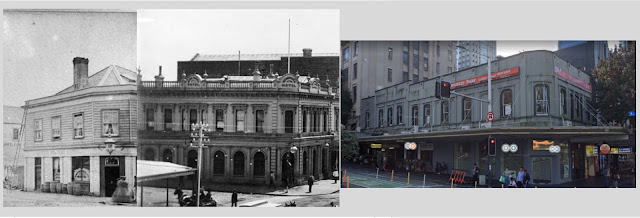The three faces of the United Service Hotel, corner Queen and Wellesley Street West, Auckland.
Originally called the Rifle Volunteers Hotel from 1860 by first publican William Baker, John and George Rayner changed the name to United Service Hotel in late June 1861.
The wooden first hotel (left) was destroyed completely in the September 1873 fire, but rebuilt in brick in 1874 by John Hancock (centre).
From 1878, Henry Nathaniel Abbott took on the lease, and tied the hotel in with his Abbott's Opera House just up the road.
The name of the hotel changed to that of the Civic Hotel in 1959, and the exterior (as well as likely the interior) was modernised at some point to the way it looks today (right).
The London Bar opened there in 1969.
The pub closed in 2006 for a time, reopened, then finally shut down in 2009. The Maze Restaurant & Bar that has taken over the space does not appear to have survived the 2020 pandemic.
Images: left -- 4-86, and centre -- 4-346, both Auckland Libraries Heritage Collections. Right is from Google streetview.


